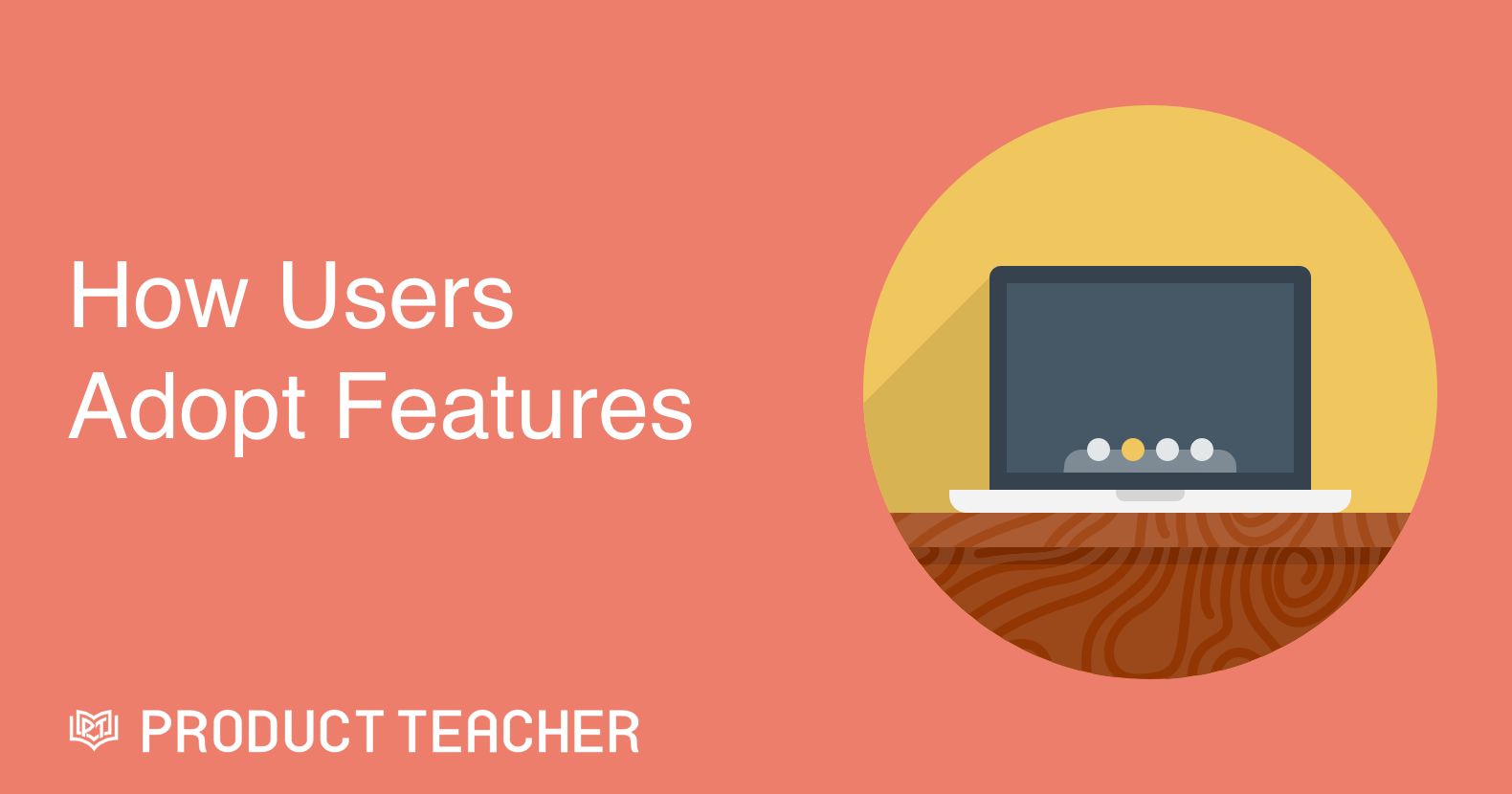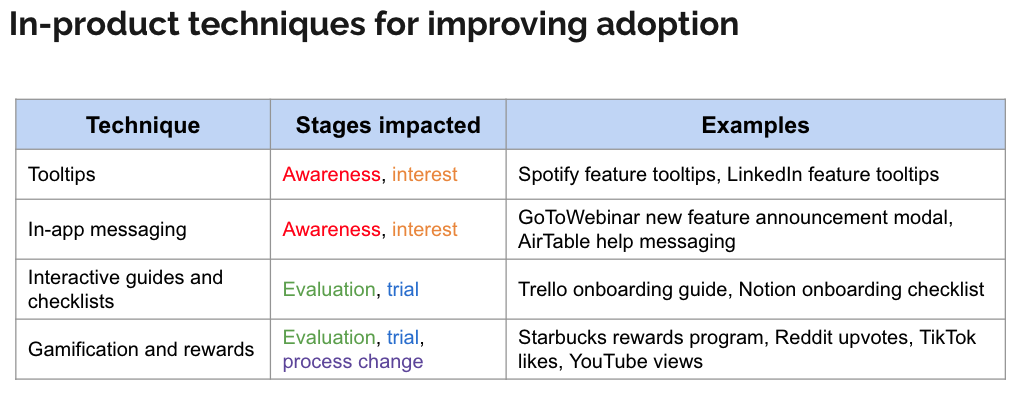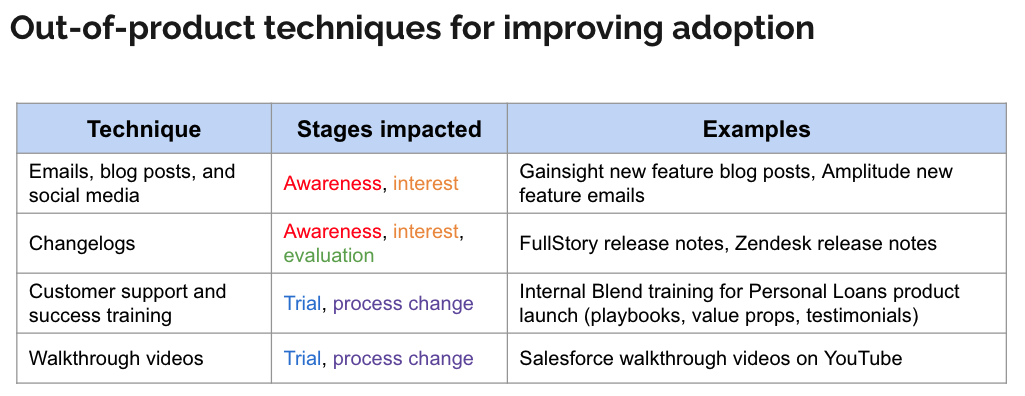How Users Adopt Features
The end goal that every product manager has is to get users to adopt their products. However, while feature adoption is fundamental to product management, not every product manager has a robust understanding of how users adopt features.
To close that gap in knowledge, I’ve written this essay on feature adoption.
First, I’ll establish the fundamentals of feature adoption by defining what feature adoption is, and the funnel through which users adopt features. Then, I’ll provide you with a set of techniques that you can use to increase new feature adoption. Finally, I’ll share some thoughts on how to measure feature adoption.
The definition of feature adoption
Feature usage is not the same as feature adoption.
Users might try new features because they’re curious about them, but trial is not the same as adoption. Adoption means that you’ve replaced their previous behaviors that were happening outside of your product.
You can only achieve true feature adoption when a user decides to incorporate your functionality into their lives. In other words, the litmus test of feature adoption is whether we’ve changed human behavior.
If your users are still running processes outside of your product, then you don’t have feature adoption. And, when you don’t have feature adoption, your users are not reaping the full benefits of your functionality.
We want users to get the maximum benefit from our products, because providing them with value helps to retain them over the long run. When your users are loyal to your product, they’re much less likely to consider competing solutions.
The feature adoption funnel
Based on my experiences in shipping and optimizing a wide range of multimillion dollar B2B products, I’ve validated this five-step funnel for visualizing how users decide to adopt features.
First, users must be aware that a given feature exists.
Second, they need to be interested in the value that this feature might provide them.
Third, they’ll evaluate whether they should learn more about the feature, and whether to bring it into their lives.
Fourth, they’ll test this feature to see for themselves whether you’ve solved their pain.
Fifth, if they decide that this feature provides them with value, they’ll mold their processes around your product.
Therefore, as you refine your product offering, answer these questions:
Awareness: how can you make it easier for people to know that your product exists?
Interest: does your product make a “promise” to your targeted users? Is that promise something that they care about?
Evaluation: how does your product compare to their current alternative? Which criteria are your users leveraging when they assess different options?
Trial: how do you minimize the time it takes for them to try out your product and see whether it beats their current solution? Can users self-serve, or do they need to speak with a rep before they can use your product?
Process change: which barriers will customers have in fully standardizing on your product (e.g. data migration, user training, etc.)? How can you ease this transition?
Each of these questions provide you with a rich set of ideas for your product roadmap. But, when it comes to that roadmap, what kinds of features or processes should you be implementing to drive feature adoption?
Techniques for maximizing feature adoption
I recommend these eight techniques for driving feature adoption:
Tooltips
In-app messaging
Interactive guides and checklists
Gamification and rewards
Emails, blog posts, and social media
Change logs
Customer support/success training
Walkthrough videos
Note that I’ve excluded standard product management processes such as “gathering customer feedback” and “analyzing product data.”
Broadly-applicable product processes aren’t specific to feature adoption, as they’re equally useful for new product launches as well as scaling existing products. So, we’ll keep those out of scope in our discussion.
I’ve created two graphics below to quickly summarize each feature adoption technique.
Use in-feature techniques like tooltips, guides, and checklists to guide users through the adoption funnel
You can also use techniques outside of your product to drive user adoption
How do I implement all of these techniques?
Product management is all about iteration. Don’t try to adopt all of these techniques at once, because you’ll quickly run out of steam!
Instead, first pick one technique that you feel would be relatively low-friction and low-cost to pursue. Different organizations have different strengths, so there’s no one-size-fits-all answer.
As an example, you might already be writing internal-facing release notes to your executives and stakeholders. If so, then it might not take a lot of effort to convert these release notes into customer-facing emails to share updates about your functionality.
But on the flip side, if you’re not writing internal-facing release notes today, then it might be a huge burden to write up these emails. Maybe it’s much easier for you to implement tooltips because you’re using integrated plugins like Pendo or Appcues, so you don’t need to dedicate engineering resources to create in-product walkthroughs.
So, take the time to assess which technique is the fastest and easiest one to implement for your organization.
Then, as you implement the technique, determine what kinds of friction you have and what kinds of challenges your stakeholders have in implementing it. Measure your successes and reflect on your progress.
Afterwards, select the next one to implement. We want to focus on speed-to-market, because changing organizational processes requires a lot of momentum. Select the next thing that would be fastest to knock out, and tackle that one.
As you work your way through the techniques above, you’ll find that you’ve created a virtuous flywheel and that you’re reaping synergistic benefits.
As an example, it’s much easier for customer support to help users if there are already tooltips for new features, and it’s much easier to train customer support on how to help users if you have tooltips available in your product.
Congrats! You’ve now gained a flexible suite of techniques that you can use to significantly increase the adoption of your features. But how exactly do we prove that we’ve moved the needle?
Tracking feature adoption
The following metrics are valuable for gaining insight into feature adoption:
Monthly active usage, defined as the % of customers using it each month
Monthly frequency, defined as the average number of times this functionality is used
Workflow depth, defined as the % of steps completed in the workflow
Monthly active usage tells us whether users are finding ongoing value in our functionality. We’ll want to use cohort analysis to find out how each cohort’s retention is trending over time. If they’ve truly adopted our functionality, then we should see long-term active usage.
Monthly frequency tells us how often users are leveraging our functionality. This metric is a proxy for whether we’re top-of-mind for users when it comes to their tasks. By analyzing how various time-based cohorts are performing, we can determine whether we’ve continued to stay top-of-mind for our users.
Workflow depth tells us whether users are abandoning our functionality partway through the flow. Workflow depth is particularly important for new users, as it helps us understand whether we’ve provided them with enough guidance and enough value for them to complete our product’s workflow from start to finish.
By using these metrics, we can establish baselines on how well our users have adopted our features. And, we can use these metrics as leading indicators for the experiments that we ship, all in service of driving long-term value for our users and customers.
Looking to learn more about how to implement feature adoption for your product team? We run workshops for product organizations, and we teach product teams how to successfully enable their user to fully embrace their products.
Summary
The best product managers don’t just aim to ship products; rather, they’re laser-focused on helping users adopt their products. Deeply changing human behavior is what unlocks true product value, rather than shallow one-off usage.
As you work on driving feature adoption, experiment with different methods in our toolkit above. Each one will yield positive results, but don’t feel obligated to use them all at the same time! Instead, experiment with each technique one at a time. You’ll get faster results that way, and you’ll ultimately build a flywheel of long-term adoption.
Thank you to Pauli Bielewicz, Mary Paschentis, Siamak Khorrami, Goutham Budati, Markus Seebauer, Juliet Chuang, and Kendra Ritterhern for making this guide possible.




